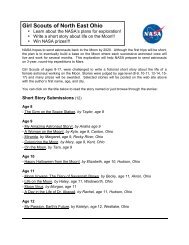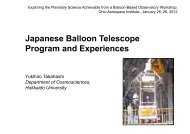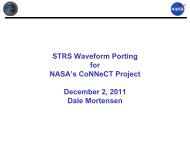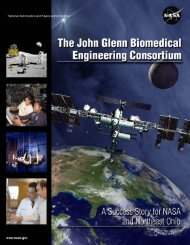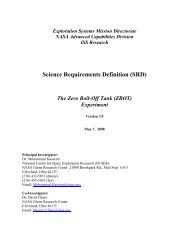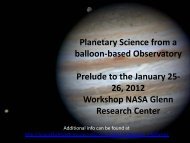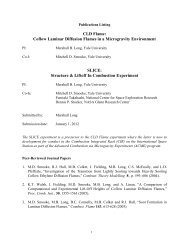Amusement Park Physics With a NASA Twist - Space Flight Systems ...
Amusement Park Physics With a NASA Twist - Space Flight Systems ...
Amusement Park Physics With a NASA Twist - Space Flight Systems ...
You also want an ePaper? Increase the reach of your titles
YUMPU automatically turns print PDFs into web optimized ePapers that Google loves.
Accelerometer<br />
A vertical accelerometer is a simple tool that can measure the<br />
upward and downward accelerations of a ride in terms of<br />
Earth’s gravity (g). At rest, the accelerometer registers 1 g, or<br />
normal Earth gravity. Earth’s gravitational attraction will pull<br />
the spring to the 1-g position. Measurements will range from<br />
–4 to 4 g on amusement park rides. You can make your own<br />
accelerometers by following these directions, or you can<br />
order an amusement park kit from a scientific supply catalog.<br />
Finding the tubes may present a problem, although thermometers<br />
are shipped in these tubes. If you plan to order a kit,<br />
allow plenty of time for delivery.<br />
Procedure-Spring-Mass Assembly<br />
1. Attach the mass to one end of the spring. Be careful not<br />
to stretch the spring out of shape.<br />
2. Bend the paper clip into a “V” shape, as shown in figure 1.<br />
3. Poke two holes in one end cap, as shown in figure 2.<br />
4. Thread the paper clip through the end of the spring without<br />
the weight, as shown in figure 3.<br />
5. Thread the paper clip (with the spring and mass) through<br />
the holes inside the cap. Bend the wires down the cap<br />
sides. Trim the excess wire (see fig. 4).<br />
Materials (per student pair)<br />
• Plastic thermometer tube<br />
• Rubber band (large)<br />
• Two end caps<br />
• Two masses or fishing sinkers<br />
(1.5 ounces)<br />
• Spring<br />
• Red tape (1/8 inch wide)<br />
• Paper clip<br />
• White duct tape or masking tape<br />
(1/2 inch wide)<br />
• Push pin<br />
• String (12 inches)<br />
• Scissors<br />
• Pliers<br />
• Permanent marker<br />
Figure 1. Figure 2.<br />
Calibration<br />
1. Put the spring, mass, and cap into the tube. Hold the tube<br />
vertically (see fig. 5).<br />
2. Carefully wrap the red tape around the tube level with the<br />
bottom of the weight. Use a narrow width of red tape.<br />
This marks the 1-g position. At the top of the tube, draw a<br />
small upward arrow.<br />
3. Remove the cap, mass, and spring from the tube.<br />
4. Tie a second mass to the end of a string. Thread the<br />
other end of the string to the loop of the spring holding<br />
the first mass. Do not tie the string tightly because you<br />
will have to untie it shortly.<br />
5. Replace the cap, spring, masses, and string through the<br />
tube. Be sure the tube has the arrow pointing up.<br />
6. Wrap another narrow piece of red tape around the tube<br />
level with the bottom of the weight. This marks the 2-g<br />
position (see fig. 6).<br />
7. Remove the cap, masses, string, and spring from the<br />
tube. Untie the string/mass from the spring. Give the<br />
string/mass to the another pair of students for<br />
calibration.<br />
Figure 3.<br />
Figure 4.<br />
Figure 5.<br />
39<br />
<strong>Amusement</strong> <strong>Park</strong> <strong>Physics</strong> <strong>With</strong> a <strong>NASA</strong> <strong>Twist</strong><br />
EG–2003–03–010–GRC



